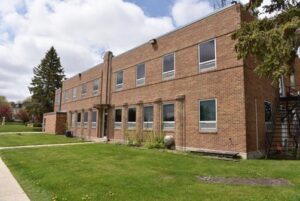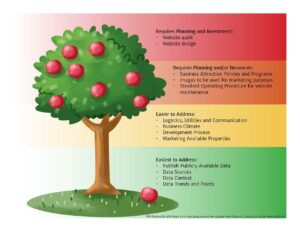About Redevelopment
Never Too Late to Start
Years of neglect and lack of upkeep yield blighted properties. Code enforcement, if implemented, works to help in some instances. But if the community hasn’t been consistently enforcing building codes and maintaining standards, it will be an uphill battle. No one wants to see play that out on the front page of the newspaper. If your community is not diligent at enforcing existing building codes, it’s never too late to start.
Carrot-and-stick Approach to Code Enforcement
A carrot-and-stick approach to code enforcement works better than a stick alone. Holding property owners accountable for the condition of their property by using the heavy hand of code enforcement alone may not be well-received. This is especially true if a blind eye has been turned to deteriorating conditions. It might be best to start with a property owner education seminar or a series of public relations outreach efforts. If your city is proactive in informing property owners about your (renewed) desire to enforce building codes, some owners may proactively address their issues. At least then you can say they were informed.
Public sector investments in property rehabilitation are often required
For whatever reason a person comes into ownership of a property, they may not have the means to keep it up or make significant repairs. Undertaking transformative rehabilitation is often the most expensive of property investment adventures. What could appear to be a simple rehab project often uncovers deeper issues. One can find aging infrastructure, structural issues, and problems lurking under surfaces. Because significant improvements to existing buildings can be so expensive, these projects often need public sector support. Investments made in a community’s architectural treasures will reap benefits in the long term. And, as redevelopment occurs, it tends to go viral. Once one property owner starts investing in a property, others decide to make improvements and the energy spreads to even more buildings. We’ve seen the first few projects in a redevelopment area require more public investment but as the flywheel begins to spin, the private sector takes the wheel and public sector support diminishes.
Examples of Public Sector Support for Building Rehabilitation:
- City Janesville Downtown Revolving Loan Fund
- City of Watertown Redevelopment Authority Revolving Loan Fund
- Wisconsin Economic Development Corporation’s (WEDC) Programs:
Community Development Grant Program
Site Assessment Grants
Idle Sites Redevelopment Program
Temporary Reduction Leads to Bigger Gains
Taking property off the tax rolls temporarily often leads to big gains which make up lost revenue when the property is replaced or redeveloped at a higher value. We’ve seen this happen time and again in communities across the country. Blighted property acquired by the public sector or demolished to make way for something bigger and better often means a temporary decrease in property taxes. But what replaces that outdated or functionally obsolete development is typically exponentially more valuable. It’s these types of politically tricky investments of money, time and energy (and foregone tax revenue) that allow for growth and development to breathe fresh life into a business district.
Think Long-term
Think long-term when making community development investment decisions. If a project doesn’t come to fruition within an election cycle, be patient and think long-term. Redevelopment is not a game for the impatient. Large-scale investments in the long-term future of the community are so impactful if given the proper time to go through all the paces. Sometimes it takes years to see the fruits of a decision made. But play the long game when it comes to redevelopment. As noted at the top of this post, properties don’t become blighted overnight. It takes a lot of time, money and political capital to get the ship sailing in the right direction.
Related Articles
The Environmental and Public Health Costs of Neglected Buildings






